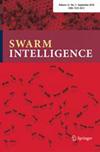仅通过仿真实验来模拟现实差距对机器人群自动设计的影响
IF 2.1
4区 计算机科学
Q3 COMPUTER SCIENCE, ARTIFICIAL INTELLIGENCE
引用次数: 33
摘要
现实差距(即现实与仿真之间的差异)是机器人群和单个机器人控制软件离线自动设计中的一个关键问题。可以理解,现实差距表现为性能的下降:当仿真中生成的控制软件移植到物理机器人时,观察到的性能通常与仿真中获得的性能相比令人失望。在本文中,我们研究是否,为了观察现实差距的影响,有必要假设控制软件是在一个比它被评估的更简单的环境中设计的。在第一个实验中,我们表明,在人工的、仅仿真的现实差距中也可能观察到性能下降:控制软件是在仿真模型的基础上生成的,并在第二个模型上进行评估。我们称第二种模式为伪现实。我们通过试错法选择仿真模型作为伪现实,从而定性地复制先前发表的物理机器人实验中的观察结果。结果表明,即使我们可以排除伪现实比用于设计的仿真模型更复杂的情况,性能也会下降。在第二个实验中,我们通过评估跨多个伪现实的控制软件来消除第一个实验的试错选择,这些伪现实是围绕用于设计的原始仿真模型采样的。第二个实验的结果证实了第一个实验的结果,并表明它们不依赖于我们之前通过试错选择的特定伪现实。此外,他们建议人们可以使用多个伪现实来评估自动设计方法,并从这种仅模拟的评估中推断出它们对现实差距的鲁棒性。本文章由计算机程序翻译,如有差异,请以英文原文为准。
Simulation-only experiments to mimic the effects of the reality gap in the automatic design of robot swarms
The reality gap—the discrepancy between reality and simulation—is a critical issue in the off-line automatic design of control software for robot swarms, as well as for single robots. It is understood that the reality gap manifests itself as a drop in performance: when control software generated in simulation is ported to physical robots, the performance observed is often disappointing compared with the one obtained in simulation. In this paper, we investigate whether, to observe the effects of the reality gap, it is necessary to assume that the control software is designed in a context that is simpler than the one in which it is evaluated. In the first experiment, we show that a performance drop may be observed also in an artificial, simulation-only reality gap: control software is generated on the basis of a simulation model and assessed on a second one. We will call this second model a pseudo-reality. We selected the simulation model to be used as a pseudo-reality by trial and error, so as to qualitatively replicate previously published observations made in experiments with physical robots. The results show that a performance drop occurs even if we can exclude that pseudo-reality is more complex than the simulation model used for the design. In the second experiment, we eliminate the trial-and-error selection of the first experiment by evaluating control software across multiple pseudo-realities, which are sampled around the original simulation model used for the design. The results of the second experiment confirm those of the first one and show that they do not depend on the specific pseudo-reality we previously selected by trial and error. Moreover, they suggest that one could use multiple pseudo-realities to evaluate automatic design methods and, from this simulation-only evaluation, infer their robustness to the reality gap.
求助全文
通过发布文献求助,成功后即可免费获取论文全文。
去求助
来源期刊

Swarm Intelligence
COMPUTER SCIENCE, ARTIFICIAL INTELLIGENCE-ROBOTICS
CiteScore
5.70
自引率
11.50%
发文量
11
审稿时长
>12 weeks
期刊介绍:
Swarm Intelligence is the principal peer-reviewed publication dedicated to reporting on research
and developments in the multidisciplinary field of swarm intelligence. The journal publishes
original research articles and occasional review articles on theoretical, experimental and/or
practical aspects of swarm intelligence. All articles are published both in print and in electronic
form. There are no page charges for publication. Swarm Intelligence is published quarterly.
The field of swarm intelligence deals with systems composed of many individuals that coordinate
using decentralized control and self-organization. In particular, it focuses on the collective
behaviors that result from the local interactions of the individuals with each other and with their
environment. It is a fast-growing field that encompasses the efforts of researchers in multiple
disciplines, ranging from ethology and social science to operations research and computer
engineering.
Swarm Intelligence will report on advances in the understanding and utilization of swarm
intelligence systems, that is, systems that are based on the principles of swarm intelligence. The
following subjects are of particular interest to the journal:
• modeling and analysis of collective biological systems such as social insect colonies, flocking
vertebrates, and human crowds as well as any other swarm intelligence systems;
• application of biological swarm intelligence models to real-world problems such as distributed
computing, data clustering, graph partitioning, optimization and decision making;
• theoretical and empirical research in ant colony optimization, particle swarm optimization,
swarm robotics, and other swarm intelligence algorithms.
 求助内容:
求助内容: 应助结果提醒方式:
应助结果提醒方式:


